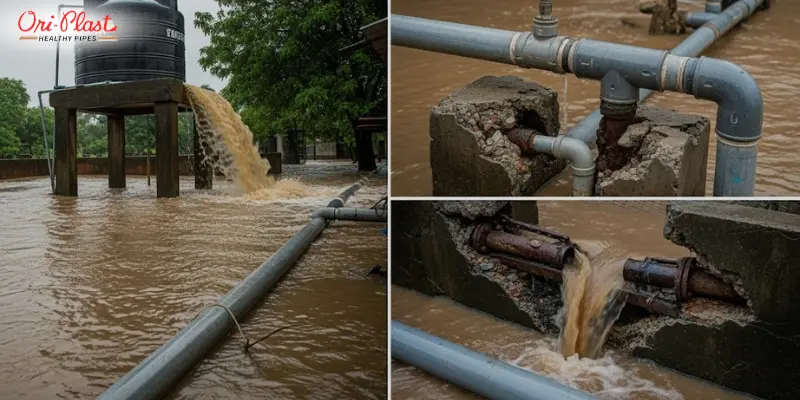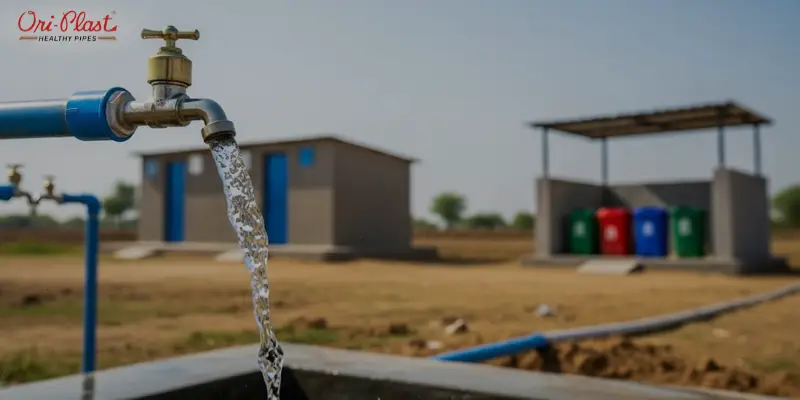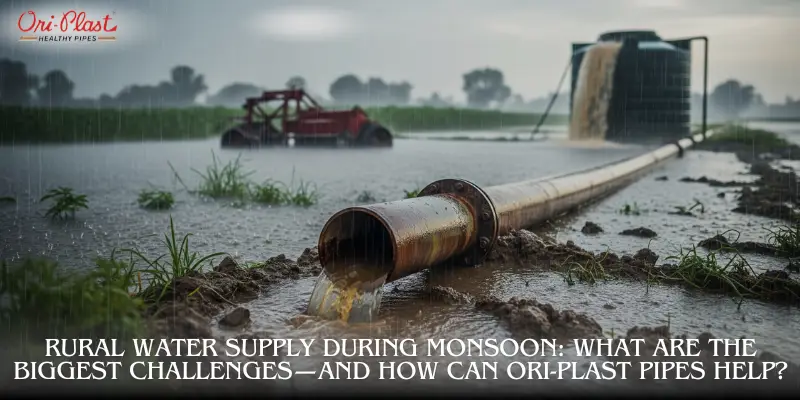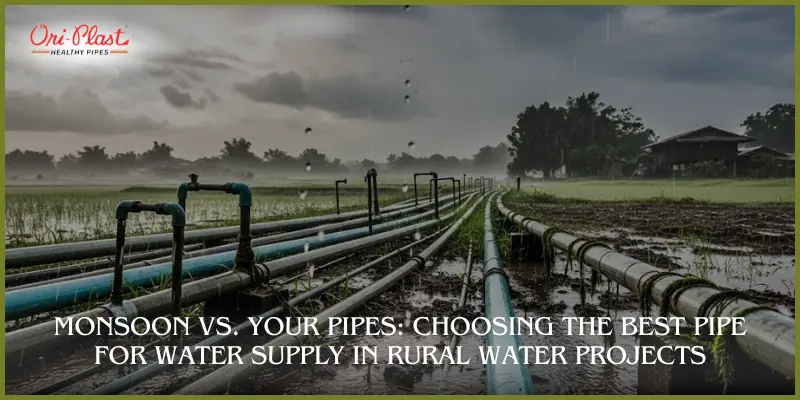Monsoon Woes: Why Rural Water Systems Break Down—and What Can Be Done. Each year, as the monsoon clouds roll in, villages across India prepare for a season of challenges. While the rain is essential for agriculture, it brings disruption in other critical areas, especially the rural water supply system.
For millions depending on community taps, borewells, and pipeline-fed tanks, the rainy season brings uncertainty. From muddy drinking water to burst pipelines and overflowing storage tanks, rural water supply systems are often pushed to the brink.
Add to that the rising pressure from ambitious government initiatives like the Jal Jeevan Mission, and it’s clear: India’s villages need a more resilient, future-ready water infrastructure. The solution lies not just in funding or design, but in choosing materials engineered to withstand real-life conditions.
This is where Ori-Plast Pipes come in. With high-performance piping solutions like HDPE and uPVC pipes, Ori-Plast offers monsoon-proof infrastructure that supports a reliable drinking water supply in rural areas.
What Exactly Is a Rural Water Supply System?
Unlike cities with centralized treatment plants and underground reservoirs, rural water supply systems are more localized and often fragmented. A typical water supply system in rural areas might consist of:
- Groundwater borewells
- Elevated storage tanks
- Long-distance pipeline networks
- Community water taps or hand pumps
These systems may be gravity-fed or pump-based, but either way, they’re vulnerable to seasonal stress and limited access to real-time maintenance.
One major difference between rural and urban water supply lies in how quickly problems can be addressed. In villages, a broken pipe or flooded chamber might take days—or even weeks—to repair. In cities, similar issues can be fixed within hours due to faster logistics and infrastructure support.
Therefore, rural water systems must be far more durable and weather-resilient by design.
Monsoon: The Ultimate Test for Water Infrastructure

During monsoons, water systems are under constant pressure—literally and figuratively. Let’s break down what typically goes wrong:
1. Pipe Displacement
Heavy rains often soften the soil. Unstable foundations lead to shifting pipelines, which can cause cracks, misalignment, or even complete dislodgment.
2. Contaminated Water
Floodwater carries pollutants, sewage, and debris. When it enters weak joints or cracked pipelines, the entire drinking water supply becomes compromised.
3. Blocked or Overflowing Storage
Water tanks, sump wells, or inlets often get clogged with silt or debris. Overflow risks increase, leading to wastage or further contamination.
4. Service Disruption
Flooded roads and remote access routes prevent technicians from performing timely repairs. Villagers are left without safe water for days.
The real cost of these water supply challenges is paid in health and productivity. People—especially children—are exposed to waterborne illnesses, while daily life grinds to a halt due to unreliable access.
Key Issues Behind Rural Water Supply Failures
Let’s take a closer look at the root issues of rural water supply, particularly during heavy rains.
Outdated Materials
Many rural setups still use GI or cement pipes that corrode easily, crack under pressure, and fail when buried in shifting soil.
Poor Pipe Jointing
Weak couplings or improper seals allow floodwater to mix with potable supply—causing health hazards.
Lack of Preventive Maintenance
In many rural regions, maintenance is reactive, not proactive. Small leaks are ignored until they become major failures.
Pressure Fluctuation
Monsoons change flow dynamics. Sudden pressure surges from backfilled tanks or blocked valves often lead to pipe bursts.
All of these point to a critical need: building a robust, leak-resistant, and easy-to-maintain water supply network.
How Can Ori-Plast Pipes Help?
When it comes to long-term infrastructure for water supply for rural areas, materials matter. Ori-Plast Pipes, backed by decades of innovation and certification (including ISO 14001:2015), offer engineered solutions to meet these exact rural and monsoon-specific needs.
Features of Ori-Plast HDPE and uPVC Pipes:
- Leak-proof joints prevent water loss and contamination
- Corrosion-resistant surfaces prolong pipe life in wet and acidic soils
- High flexibility handles soil shifts and reduces the risk of cracking
- Smooth inner surface ensures consistent flow even under high pressure
- Lightweight construction allows easy transportation and installation, even in remote villages
Supporting Jal Jeevan Mission & Rural Sanitation

Ori-Plast is already contributing to large-scale rural water and sanitation efforts, including the Jal Jeevan Mission and NGO-led water initiatives. Their durable pipe systems are trusted for water supply and sanitation in both flood-prone and drought-prone zones across India.
Whether it’s piping drinking water, supporting irrigation lines, or managing sanitation flow, Ori-Plast Pipes offer a long-term, cost-effective solution for governments, contractors, and civil engineers.
Real-Life Application: How Durable Pipes Changed a Village’s Future
Let’s take the example of a flood-prone village in Odisha. The village faced yearly pipeline damage during monsoons, resulting in 10–15 days of no water access. After upgrading to Ori-Plast’s HDPE pipes, results included:
- Zero leakage during monsoon
- No service disruption
- Significant drop in waterborne illnesses
- 35% reduction in maintenance costs over one year
This case demonstrates the effectiveness of investing in quality material and design. The rural water supply became not just stable, but resilient.
Why Durable Pipes Pay Off in the Long Run
Opting for quality pipes isn’t just a short-term fix—it delivers tangible long-term benefits:
- Healthier communities due to safe, continuous drinking water
- Lower maintenance costs, freeing up government budgets
- Higher ROI on water infrastructure projects
- Improved trust among villagers in local water governance
- Supports sustainable development goals for clean water access
A strong water supply network built with durable materials like Ori-Plast reduces the cycle of failure and repair, allowing rural development to flourish.
Rural Water Supply and Sanitation: One System, Many Benefits
It's important to see water delivery and sanitation as a combined system. Poor water quality affects hygiene, and poor sanitation impacts water sources. Ori-Plast’s range of pipes is suitable for both segments, helping villages:
- Keep drinking water and wastewater systems separate
- Prevent cross-contamination
- Meet safety standards under government schemes
- Build an integrated water supply and sanitation model
In this way, a well-designed pipeline system becomes the backbone of rural health, hygiene, and development.
Conclusion: Invest in Resilient Water Systems—Invest in the Future
Monsoons will continue to test India’s rural infrastructure—but we can choose how we respond. Investing in certified, durable, and tested piping solutions like Ori-Plast Pipes ensures that rural water supply is no longer vulnerable to seasonal setbacks.
Engineers, policymakers, and contractors must prioritize long-lasting solutions over temporary fixes. And Ori-Plast stands ready—with products that work in the real world, for real communities.
Looking for Leak-Proof Pipes That Work Even in the Toughest Monsoon?
Explore advanced HDPE and uPVC pipe systems for rural water supply networks at www.oriplast.com. Get expert consultation for designing smart, durable solutions tailored to your project’s specific needs.
Frequently Asked Questions (FAQs)
1. What are the biggest challenges during the monsoon in rural areas?
The main challenges include pipe bursts due to shifting soil, contamination from floodwater, overflowing tanks, blocked systems, and delayed repairs. These issues disrupt consistent access to clean drinking water in villages.
2. Why does the monsoon affect the drinking water supply in rural areas?
Flooding and soil erosion during monsoon cause physical damage to pipelines and allow polluted water to enter the system. This leads to unreliable and unsafe drinking water supply in rural areas.
3. What is a rural water supply system?
A rural water supply system typically consists of borewells, pumps, storage tanks, pipelines, and community taps. These systems deliver water to scattered populations in remote or underdeveloped areas.
4. How does rural water supply differ from urban water supply?
Rural water systems are usually decentralized and more exposed to environmental factors like flooding or erosion. In contrast, urban water supply systems benefit from better infrastructure, quicker maintenance, and centralized control.
5. What are the common issues of rural water supply systems?
Key issues include outdated materials, weak pipe joints, lack of maintenance, and poor planning. These vulnerabilities are often exposed during monsoon, leading to water shortages or contamination.
6. How can HDPE and uPVC pipes improve water supply?
HDPE and uPVC pipes are corrosion-resistant, leak-proof, and highly flexible. They can withstand soil shifts and pressure changes, making them ideal for building a durable water supply network.
7. How do modern pipe systems support water supply and sanitation?
Modern pipes prevent leaks and contamination, ensuring clean water reaches every household. They also help manage wastewater effectively, supporting integrated water supply and sanitation systems.
8. What role do Ori-Plast Pipes play in rural water projects?
Ori-Plast provides high-quality HDPE and uPVC pipes that are certified and engineered for tough rural conditions. These pipes help ensure long-term, monsoon-resistant water infrastructure.
9. Why is it important to use durable pipes in rural water systems?
Durable pipes reduce breakdowns, prevent health hazards, lower maintenance costs, and extend the life of rural water infrastructure—especially in flood-prone or hard-to-access areas.
10. What type of pipe is best for water supply in rural areas during monsoon?
Pipes made from HDPE or uPVC are best suited for water supply in rural areas. They resist corrosion, handle high water pressure, and adapt to shifting soil—ensuring uninterrupted supply even during monsoon.


